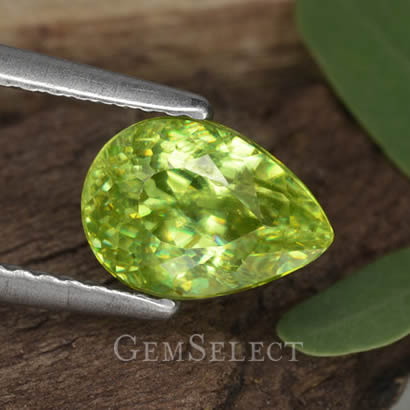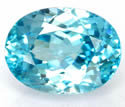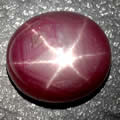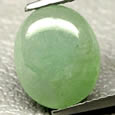Your Details
Your Details
|
Reviewed By Andreas Zabczyk
Brilliance, Luster & FireYou'll often hear the words brilliance, luster and fire used in describing fine gemstones. These are not just terms of approval used by those who know - or think they know - gemstones. Rather these are actually technical terms that have fairly precise meanings, even if they are often misused. 
Brilliant Sphene Gemstone

Blue Zircon
All three of these terms have to do with the appearance of a gemstone as it reflects light. Brilliance pertains to the light that is reflected from within a gem, making it a characteristic exclusive to transparent gemstones. On the contrary, luster refers to the light reflected from the surface of a gem. If someone mistakenly describes an opaque star ruby as "brilliant," they are using the term incorrectly. In such cases, it would be more appropriate for them to discuss the ruby's luster instead. Shop all brilliant gemstones. 
Demantoid Garnet
The brilliance in gemstones - the amount of light reflected back out of the crown to the eye - is caused by the gem material's refractive index as well as its cut. Gems with high refractive indices, such as diamond, sphene, zircon, garnet, sapphire and ruby, are usually cut to maximize their considerable brilliance. This means that the pavilion facets must be cut at the correct angles so that light will be reflected back out of the crown instead of passing through the bottom of the gem. In gemstones with much lower refractive indices, such as quartz, it often makes more sense to optimize the cut for color rather than brilliance, since a cut optimized for brilliance would result in a very deep pavilion that would be harder to set into jewelry. 
Star Ruby
Where brilliance is measured simply in terms of 'more or less', there are a set of technical terms used by gemologists to refer to different types of luster. A gemstone with a surface that is reflective like polished gold or silver has a luster that is called metallic; only a few gems such as hematite and pyrite exhibit this quality. A diamond-like luster is known as adamantine, a quality shared not only by diamond, but also by some other gemstones such as sphene, demantoid garnet and zircon. A vitreous or glass-like luster is the most common among transparent faceted gems, including sapphire, ruby, emerald and tourmaline. Other lusters include silky (e.g. tiger's eye), resinous (e.g. amber) and greasy (e.g. jadeite). 
Natural Jade
Fire refers to the tendency of a gemstone to split light into its spectral colors. The gemological term for this is dispersion. Dispersion occurs when different wavelengths of light are refracted by the internal facets of a gemstone. Diamond is famed for this quality, but a number of other gemstones are notable for their fire, including demantoid garnet, sphene and zircon. |
